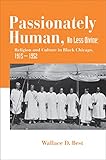Passionately Human, No Less Divine : Religion and Culture in Black Chicago, 1915-1952 / Wallace D. Best.
Material type: TextPublisher: Princeton, NJ : Princeton University Press, [2013]Copyright date: ©2005Edition: Course BookDescription: 1 online resource (272 p.) : 12 halftones. 3 line illus. 3 tablesContent type:
TextPublisher: Princeton, NJ : Princeton University Press, [2013]Copyright date: ©2005Edition: Course BookDescription: 1 online resource (272 p.) : 12 halftones. 3 line illus. 3 tablesContent type: - 9780691133751
- 9781400849345
- 277.3/11/08208996073 22
- BR563.N4
- online - DeGruyter
- Issued also in print.
| Item type | Current library | Call number | URL | Status | Notes | Barcode | |
|---|---|---|---|---|---|---|---|
 eBook
eBook
|
Biblioteca "Angelicum" Pont. Univ. S.Tommaso d'Aquino Nuvola online | online - DeGruyter (Browse shelf(Opens below)) | Online access | Not for loan (Accesso limitato) | Accesso per gli utenti autorizzati / Access for authorized users | (dgr)9781400849345 |
Browsing Biblioteca "Angelicum" Pont. Univ. S.Tommaso d'Aquino shelves, Shelving location: Nuvola online Close shelf browser (Hides shelf browser)

|

|

|

|

|

|

|
||
| online - DeGruyter Fossil Legends of the First Americans / | online - DeGruyter The Handless Maiden : Moriscos and the Politics of Religion in Early Modern Spain / | online - DeGruyter Press "ONE" for English : Language Policy, Public Opinion, and American Identity / | online - DeGruyter Passionately Human, No Less Divine : Religion and Culture in Black Chicago, 1915-1952 / | online - DeGruyter Collecting the New : Museums and Contemporary Art / | online - DeGruyter When Computers Were Human / | online - DeGruyter Twelve Who Ruled : The Year of Terror in the French Revolution / |
Frontmatter -- Contents -- Abbreviations -- Figures -- Tables -- Preface -- Acknowledgments -- Introduction -- Chapter One. "Mecca of the Migrant Mob" -- Chapter Two. The South in the City -- Chapter Three. Southern Migrants and the New Sacred Order -- Chapter Four. The Frenzy, the Preacher, and the Music -- Chapter Five. The Chicago African Methodist Episcopal Church in Crisis -- Chapter Six. A Woman's Work, or Urban World -- Epilogue -- Notes -- Index
restricted access online access with authorization star
http://purl.org/coar/access_right/c_16ec
The Great Migration was the most significant event in black life since emancipation and Reconstruction. Passionately Human, No Less Divine analyzes the various ways black southerners transformed African American religion in Chicago during their Great Migration northward. A work of religious, urban, and social history, it is the first book-length analysis of the new religious practices and traditions in Chicago that were stimulated by migration and urbanization. The book illustrates how the migration launched a new sacred order among blacks in the city that reflected aspects of both Southern black religion and modern city life. This new sacred order was also largely female as African American women constituted more than 70 percent of the membership in most black Protestant churches. Ultimately, Wallace Best demonstrates how black southerners imparted a folk religious sensibility to Chicago's black churches. In doing so, they ironically recast conceptions of modern, urban African American religion in terms that signified the rural past. In the same way that working class cultural idioms such as jazz and the blues emerged in the secular arena as a means to represent black modernity, he says, African American religion in Chicago, with its negotiation between the past, the present, rural and urban, revealed African American religion in modern form.
Issued also in print.
Mode of access: Internet via World Wide Web.
In English.
Description based on online resource; title from PDF title page (publisher's Web site, viewed 29. Jul 2021)


